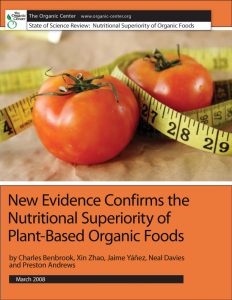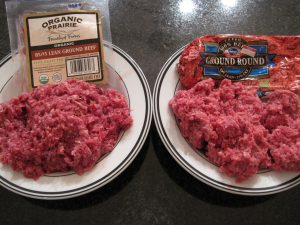 Most consumers initially seek out organic food in the hope of avoiding pesticide residues, food additives, genetically engineered ingredients, and a long list of other substances that certified organic farmers and organic food companies cannot use.
Most consumers initially seek out organic food in the hope of avoiding pesticide residues, food additives, genetically engineered ingredients, and a long list of other substances that certified organic farmers and organic food companies cannot use.
They do so in the hope of improving their health and/or the health of their children and family members. Others choose to buy organic food to support organic farmers, because of the proven benefits of organic farming on the environment and animal welfare.
Even the U.S. Department of Agriculture has officially acknowledged that organic farming systems lighten agriculture’s environmental footprint, combat global warming by sequestering extra carbon in the soil, and promote biodiversity.
In recent years science has identified another reason to purchase organic food – improved nutritional quality.

A solid body of research now confirms that on average, and across production years, regions, and different soil types, organic farming increases the concentration of a variety of health-promoting nutrients in plant-based foods (fruit, vegetables, grains, nuts).
While a few nutrients sometimes are marginally higher in some conventionally grown plant-based foods (the most common is protein, a nutrient not in short supply in the typical American diet), organic food typically contains higher concentrations of several of the most important nutrients that most Americans need to consume more of on a daily basis. These include antioxidants, vitamins, heart-healthy fatty acids, and minerals.
Organic meat, eggs, and dairy products also offer significant and consistent nutritional benefits. The most important by far arises from the much healthier mix of fatty acids in organic livestock products, compared to conventional animal products raised on high-energy, grain-based rations.
While most major food companies have begun to offer some organic product lines, the majority of their sales and profits still come from conventionally grown foods, and food ingredients. Many in the industry, and most food industry professional and trade associations, fear that consumer interest in, and support of organic food will be “bad for business.”
For this reason, there is no shortage of critical commentary when a new study emerges supporting the nutritional benefits of organic food and farming. In addition, scientists continue to receive support from industry, foundations, and government agencies to take a “fresh look” at the nutritional-quality benefits of organic farming.
Even the strongest runner will tire running uphill. The body of science firmly supporting the nutritional benefits of organic food is large and growing. The results are encouraging, and will eventually shift attitudes in the food industry and government. Hygeia Analytics will follow this debate closely and occasionally contribute to it.

Hygeia Analytics has compiled a large body of peer-reviewed research that documents that many scientists believe that organic food is healthier. This page is a portal for important, large-scale meta-analyses that have taken a comprehensive comparative look at the nutritional quality of organically and conventionally grown foods, as well as more food-specific focused studies.
Meta-analysis is a statistical tool scientists use to extract more robust insights from several different studies focused on the same basic question, like “does organic milk offer nutritional advantages for consumers, compared to milk from cows on conventionally managed farms?” Or, do drugs of “X” class prevent cardiovascular disease?
Each study is discussed briefly below, with links to the full text, FAQs, and other related content.
While this body of work has not convinced everyone that organic food is more nutritious, it has clearly moved the scientific consensus in that direction.
If organic farming systems worldwide continue to promote soil quality and biologically-based methods of pest management, it is likely the differences observed in past studies will persist. The wild card in this equation is what will happen to nutrient density on conventionally managed farms.
Some farmers not seeking organic certification are adopting many methods pioneered by organic farmers, and it is possible the nutrient levels in their harvests will trend upward, and even may one day match those on nearby organic farms.
But other conventional farmers are doubling-down on fertilizer and pesticide-intensive methods that will likely continue to erode nutrient levels, adding to the gap between nutrient levels in conventional vs. organic food.
Related Keywords:
Other Resources
- 2015 paper by Dominika Sreddnicka-Tober et al in Journal of Research and Applications in Agricultural Engineering reviewing research on the impacts of organic foods on human health
Milk and Dairy Products

2018 Grassmilk Paper
Authors: Charles M. Benbrook, Donald R. Davis, Bradley J. Heins, Maged A. Latif, Carlo Leifert, Logan Peterman, Gillian Butler, Ole Faergeman, Silvia Abel-Caines, Marcin Baranski
Title: “Enhancing the Fatty Acid Profile of Milk through Forage-Based Rations, with Nutrition Modeling of Diet Outcomes”
Journal: Food Science and Nutrition
Building on the PLOS One paper from 2013, this study was the first to look at the fatty acid profile of grassmilk. Results show that when the ration fed to dairy cows contains essentially 100% grass and forage-based feeds, milk has more than double the content of key, heart-healthy fats — in particular the polyunsaturated fats known as omega-3s, and conjugated linoleic acid, or CLA. Nutritional modeling shows that the significant increase in the levels of omega-3s and CLA in grassmilk, and grassmilk-based dairy products, could have a big impact on health trends by enhancing the overall quality of fat in the American diet.
2016 Dairy Product Meta-Analysis
Authors: Dominika Średnicka-Tober, Marcin Barański, Chris J. Seal, Roy Sanderson, Charles Benbrook, Håvard Steinshamn, Joanna Gromadzka-Ostrowska, Ewa Rembiałkowska, Krystyna Skwarło-Sońta, Mick Eyre, Giulio Cozzi, Mette Krogh Larsen, Teresa Jordon, Urs Niggli, Tomasz Sakowski, Philip C. Calder, Graham C. Burdge, Smaragda Sotiraki, Alexandros Stefanakis, Sokratis Stergiadis, Halil Yolcu, Eleni Chatzidimitriou, Gillian Butler, Gavin Stewart and Carlo Leifert
Title: “Higher PUFA and n-3 PUFA, conjugated linoleic acid, α-tocopherol and iron, but lower iodine and selenium concentrations in organic milk: a systematic literature review and meta- and redundancy analyses”
Journal: British Journal of Nutrition
This study found that organic milk and dairy products are healthier because they contain higher levels of health-promoting omega-3 fatty acids, including more very long-chain omega-3s. Overall, organic milk and dairy products also have a far healthier mix of fatty acids. The concentration of health-promoting, total poly-unsaturated fatty acids (PUFAs) in organic milk and dairy products was, on average, 7% higher than in corresponding milk and dairy products from conventionally managed livestock farms. Also, health-promoting omega-3 fatty acids in dairy products were, on average, 46% higher than in conventional milk and dairy products. Importantly, the overall concentration of the critical, very long-chain omega-3 fatty acids was 58% higher in organic versus conventional diary products. In addition, the concentration of the heart-healthy fatty acid CLA (conjugated linoleic acid) was 34% higher in organic milk and dairy products. The ratio of omega-6 to omega-3 fatty acids was also 79% lower in organic milk and dairy products, an important advantage for individuals dealing with or working to avoid heart disease, diabetes, chronic inflammation, and overweight. The typical balance in omega-6 to omega-3 fatty acid intakes in the U.S. is 10:1 to 15:1, a range that is clearly a risk factor for a number of chronic health problems.
Plus, there are nutritional advantages linked to organic milk consumption beyond fat levels and quality. The Newcastle meta-analysis found that organic milk contains, on average, significantly higher levels of α-tocopherol (Vitamin E) and iron (Fe), but lower concentrations of iodine (I) and selenium (Se), compared to conventional milk. The meta-analysis also identified trends towards higher vitamin A, ß-carotene, lutein and zeaxanthin, potassium (K), and lower copper (Cu) levels in organic milk, but further studies are required to confirm these results.
2013 PLOS ONE Milk Study
Authors: Charles M. Benbrook, Gillian Butler, Maged A. Latif, Carlo Leifert, and Donald R. Davis
Title: “Organic Production Enhances Milk Nutritional Quality by Shifting Fatty Acid Composition: A United States–Wide, 18-Month Study”
Journal: PLOS One
On December 9, 2013, Dr. Benbrook and his team published an 18-month, nationwide study (full study and summary available) that confirmed that there are large and consistent differences in the fatty acidprofile of organic and conventional milk and dairy products in the U.S. The research was carried out by a team led by scientists at Washington State University and appeared in the prestigious peer-reviewed journal PLOS ONE.
In typical American diets, people consume around 15 grams of omega-6 (ω-6) fatty acids for each gram of omega-3 (ω-3) fatty acids, resulting in an ω-6/ω-3 ratio of 15 — a level far above the heart-healthy goal of around 2:1, or lower. For more information about fatty acids to help interpret these results, see Good Fat, Bad Fat or this detailed primer.
The PLOS ONE study found that both organic and conventional milk and dairy products help lower this key ratio. The average ω-6/ω-3 ratio found in this study for the Organic Valley brand of organic milk is 2.3, while in conventional milk the average ratio is 5.7, still substantially better than most sources of fat in the American diets. The ω-6/ω-3 ratio in organic milk is much lower than in conventional milk, because pasture and forage-based feeds make up a much greater share of daily “Dry Matter Intake” on organic dairy farms, compared to conventional dairy farms. The team also reports that simple steps by consumers can markedly lower an individual’s overall dietary ω-6/ω-3 intake ratio. Overall, they report that organic whole milk had 62% more total ω-3 fatty acids than conventionally produced milk. Among individual ω-3 fatty acids, organic milk concentrations were 60% higher for ALA (alpha-linolenic acid), 33% higher for EPA (eicosapentaenoic acid), and 18% higher for DPA (docosahexaenoic acid). Organic whole milk had, on average year round, 18% higher levels of CLA (conjugated linoleic acid) than conventional milk, 25% lower total ω-6 fatty acids, and 25% lower concentration of LA, the major ω-6 fatty acid.
Related Keyword(s):
Multi-Food Meta Analyses
2016 Meat Products

Authors: Średnicka-Tober D, Barański M, Seal C, Sanderson R, Benbrook C, Steinshamn H, Gromadzka-Ostrowska J, Rembiałkowska E, Skwarło-Sońta K, Eyre M, Cozzi G, Krogh Larsen M, Jordon T, Niggli U, Sakowski T, Calder PC, Burdge GC, Sotiraki S, Stefanakis A, Yolcu H, Stergiadis S, Chatzidimitriou E, Butler G, Stewart G, Leifert C.
Title: “Composition differences between organic and conventional meat: a systematic literature review and meta-analysis”
Journal: British Journal of Nutrition
This study documented that organic meat is healthier because it has a markedly more desirable composition of fatty acids. The concentration of health-promoting poly-unsaturated fatty acids (PUFAs) in organic meats was, on average, 23% higher than in corresponding meat products from conventional managed livestock farms. Plus, the levels of health-promoting omega-3 fatty acids were, on average, 47% higher than in conventional meat, and the overall concentration of the critical, long-chain PUFA fatty acids was also markedly higher in organic versus conventional meat. In addition to higher concentrations of health-promoting fatty acids, the team found that the levels of some pro-inflammatory fats were lower in organic meat products. The levels of the saturated fatty acids myristic acid were, on average, 18% lower, while the levels of palmitic acid were 11% lower.
Related Keyword(s):
2013 Plant-Based Foods
Authors: Marcin Baranski, Dominka Srednicka-Tober, Nikolaos Volakakis, Chris Seal, Roy Sanderson, Gavin B. Stewart, Charles Benbrook, Bruno Biavati, Emilia Markellou, Charilaos Giotis, Joanna Gromadzka-Ostrowska, Ewa Rembiałkowska, Krystyna Skwarło-Son, Raija Tahvonen, Dagmar Janovska, Urs Niggli, Philippe Nicot and Carlo Leifert
Title: “Higher antioxidant and lower cadmium concentrations and lower incidence of pesticide residues in organically grown crops: a systematic literature review and meta-analyses”
Journal: British Journal of Nutrition
This study has three main findings. (1) Organic crops have, on average, higher levels of antioxidants than conventional crops, (2) organic crops have lower cadmium levels than conventional crops, and (3) pesticide residues are present much more frequently in conventional crops than organic ones. Particularly compelling is the fact that organic crops have, on average, significantly higher levels of antioxidants than conventional crops. Average total antioxidant activity was a 17% higher in organic versus conventional crops. For some individual antioxidants, the differences were much greater — 69% higher levels of flavanones, 28% higher levels of stilbenes, 50% higher levels of flavonols, and 51% higher levels of anthocyanins.
- Frequently Asked Questions
- Presentation of Key Figures (pdf)
- Press Release
- Organic Crops Booklet
- Supplemental Data
Media coverage:
- “Clear differences between organic and non-organic food, study finds,” July 2014, The Guardian
- “Study of Organic Crops Finds Fewer Pesticides and More Antioxidants,” July 2014, The New York Times
- “Organic foods are more nutritious, according to review of 343 studies,” July 2014, Los Angeles Times
- “Are Organic Vegetables More Nutritious After All?,” July 2014, NPR on radio interview
- “Is Organic Food Really Healthier?,” July 2014, Time
- “Parsing of Data Led to Mixed Messages on Organic Food’s Value,” October 2012, The New York Times
2012 Smith-Spangler et al.
Authors: Crystal Smith-Spangler, Margaret L. Brandeau, Grace E. Hunter, J. Clay Bavinger, Maren Pearson, Paul J. Eschbach, Vandana Sundaram, Hau Liu, Patricia Schirmer, Christopher Stave. Ingram Olkin, and Dena M. Bravata
Title: “Are Organic Foods Safer or Healthier Than Conventional Alternatives?”
Journal: Annals of Internal Medicine
Crystal Smith-Spangler, MD and her team concluded that “the published literature lacks strong evidence that organic foods are significantly more nutritious than conventional foods. Consumption of organic foods may reduce exposure to pesticide residues and antibiotic-resistant bacteria.” Dr. Benbrook and other experts have critiqued this study widely, as described in the related content below.
- Letters to the Annals of Internal Medicine Editor re the Smth-Spangler et al. paper
- The Organic Center Response to Smith-Spangler et al. by Charles Benbrook
- WSU Blog on Smith-Spangler et al.
- “Parsing of Data Led to Mixed Messages on Organic Food’s Value,” October 2012, The New York Times
2009 Dangour et al.
Author: Alan D Dangour, Sakhi K Dodhia, Arabella Hayter, Elizabeth Allen, Karen Lock, and Ricardo Uauy
Title: “Nutritional quality of organic foods: a systematic review”
Journal: American Journal of Clinical Nutrition
This team of British scientists was funded by the U.K. Food Standards Agency and concluded that organic food offered no significant nutritional benefits. The results of this study by Dangour et al. are presented – and criticized – in the links below.
- Letters to the Editor of the AJCN on Dangour et al. and Dangour et al. Responses
- TOC Response to Dangour et al. by Dr. Charles Benbrook
2008 The Organic Center Report
Author: Charles Benbrook, Xin Zhao, Jaime Yáñez, Neal Davies and Preston Andrews
Title: “State of Science Review: Nutritional Superiority of Organic Foods”
 In March, 2008 The Organic Center (TOC) released a thorough review and meta-analysis of the differences in nutrient concentrations across 236 matched pairs of organic versus conventionally grown foods that concluded that organic foods were nutritionally superior to conventionally grown. These results are compiled from 97 high-quality studies published since 1980. Click here for the full report or see the executive summary in English and Spanish.
In March, 2008 The Organic Center (TOC) released a thorough review and meta-analysis of the differences in nutrient concentrations across 236 matched pairs of organic versus conventionally grown foods that concluded that organic foods were nutritionally superior to conventionally grown. These results are compiled from 97 high-quality studies published since 1980. Click here for the full report or see the executive summary in English and Spanish.
Food Specific Comparisons
General
- Organic Diet Improves Indicators of Health in a Novel European Experiment
- “Food For Thought: Researchers Investigating Different Farming Practices Should Not Have to Pick Sides,” 2014 editorial in Nature
- “Novel Approach for Food Safety Evaluation: Results of a Pilot Experiment To Evaluate Organic and Conventional Foods,” Journal of Agriculture and Food Chemistry article, 2004
- Italian Scientists Develop Novel Approach to Compare the Safety of Organic and Conventional Foods
Fruits and Vegetables
- Superior Nutrient Content Reported in Organic Blueberries
- Antioxidants in Strawberries Reduce Oxidative Damage in the Brain and Can Reduce the Risk of Alzheimer’s Disease
- Soil Quality from Long-term Organic Management Nearly Doubles Flavonoids in Organic Tomatoes
- Organic Catsup Found to Contain More Than 50% Higher Levels of the Beneficial Antioxidant Lycopene
- Higher Levels of Vitamin C and Lower Concentrations of Nitrogen Found in Organic Oranges
Wines and Wine Grapes
- Key Differences Found Between Organic and Conventional Red Wines
- Organic Grapes Contain Higher Levels of Latent Polyphenol Oxidase then Conventionally Grown Wine Grapes
- Conventionally Grown Syrah Grapes Show Higher Concentrations of Anthocyanins than Organically Grown
